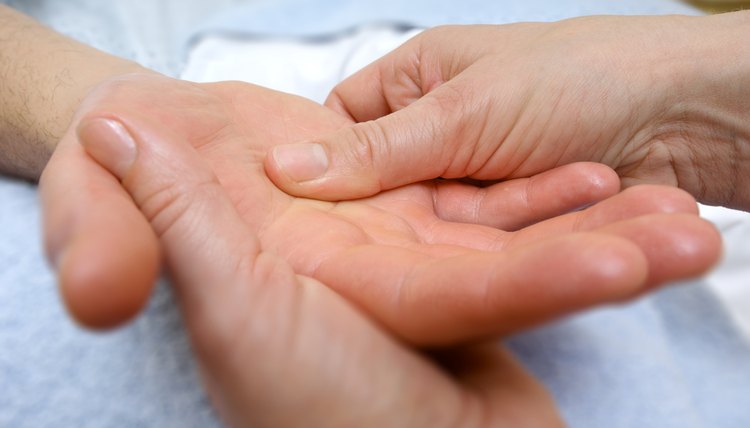Finger Blocking Exercises

Finger blocking exercises are rehab exercises that involve isolating certain finger or thumb joints in order to prevent surgery complications and restore strength. According to Eaton Hand, tendon adhesions is the most common problem following tendon repair, and finger blocking exercises are specifically designed to prevent this complication.
Basics
Finger blocking exercises help the gliding of the flexor and extensor tendons of the fingers, and as an added benefit also help to improve your grip. When used as part of rehab, the exercises strengthen, restore range of motion and prevent stiffness and loss of motion from tendon adhesions. Therapy Library notes that these exercises may be too difficult to perform directly after surgery or injury, so consult your doctor about when it is safe to add them to your rehab routine.
DIP Blocking
The DIP joint is the end, or top, joint of the finger. DIP blocking helps to restore range of motion and strength in the end joint; perform this on any of the fingers except for the thumb. Start by supporting the finger with your other hand just below the end joint and just above the middle joint. Then bend and straighten the finger using only the end joint, while holding the rest of the fingers straight, extended and motionless.
PIP Blocking
The PIP is the middle joint nearest the knuckle joint, and PIP blocking prevents stiffness and increases strength and range of motion. Extend the fingers and use your other hand to apply pressure to support or brace the finger just below the middle joint. Hand Surgical Associates notes that your target stabilization area should be right around where you would wear a ring. Bend and extend the finger using only the middle joint, keeping the rest of the fingers extended and motionless.
Thumb Blocking
You can perform thumb blocking exercises in two places as well, though they are a little trickier to find. To work the top joint of the thumb, support or hold the thumb just below the last joint and then bend and extend the thumb using only the last joint. To work the knuckle of the thumb, apply pressure and stabilize just below the base of the thumb. Therapy Library says to apply pressure just below the crease that allows the knuckle to bend. Then bend and straighten the thumb using only the knuckle or base joint.
References
- E-Hand.com: The Electronic Textbook of Hand Surgery: Complications in Hand Surgery
- Van veenendaal LM, De klerk G, Van der velde D. A painful finger as first sign of a malignancy. Geriatr Orthop Surg Rehabil. 2014;5(1):18-20. doi:10.1177/2151458514522125
- Oetgen ME, Dodds SD. Non-operative treatment of common finger injuries. Curr Rev Musculoskelet Med. 2008;1(2):97-102. doi:10.1007/s12178-007-9014-z
- Prucz RB, Friedrich JB. Finger joint injuries. Clin Sports Med. 2015;34(1):99-116. doi:10.1016/j.csm.2014.09.002
- Christensen T, Sarfani S, Shin AY, Kakar S. Long-term outcomes of primary repair of chronic thumb ulnar collateral ligament injuries. Hand (N Y). 2016;11(3):303-309. doi:10.1177/1558944716628482
- Spies CK, Langer M, Hahn P, Müller LP, Unglaub F. The treatment of primary arthritis of the finger and thumb joint. Dtsch Arztebl Int. 2018;115(16):269-275. doi:10.3238/arztebl.2018.0269
- Deveza LA, Hunter DJ, Wajon A, et al. Efficacy of combined conservative therapies on clinical outcomes in patients with thumb base osteoarthritis: protocol for a randomised, controlled trial (COMBO). BMJ Open. 2017;7(1):e014498. doi:10.1136/bmjopen-2016-014498
- Makkouk AH, Oetgen ME, Swigart CR, Dodds SD. Trigger finger: etiology, evaluation, and treatment. Curr Rev Musculoskelet Med. 2008;1(2):92-6. doi:10.1007/s12178-007-9012-1
- Alla SR, Deal ND, Dempsey IJ. Current concepts: mallet finger. Hand (N Y). 2014;9(2):138-44. doi:10.1007/s11552-014-9609-y
Writer Bio
Based in Harker Heights, Texas, Timothy Onkst has been writing about sports, fitness and health since 2003. His articles have appeared in a variety of publications including "Texas Roundball" magazine, Yahoo Sports, Fox Sports and other websites.
